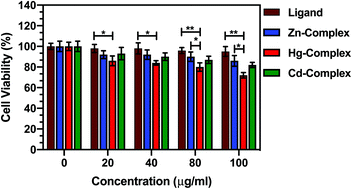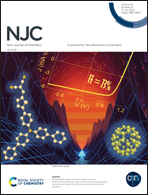Development of a novel carboxamide-based off–on switch fluorescence sensor: Hg2+, Zn2+ and Cd2+†
Abstract
Here, the carboxamide ligand N-(thiazole-2-yl) picolinamide (L) was synthesized in an ionic liquid tetrabutylammonium bromide (TBAB) as the benign reaction medium. The sensitivity of L towards different metal-ions was investigated, and a comprehensive, logical optical investigation was conducted for the IIB transition metal ions, Hg2+, Cd2+ and Zn2+, based on off–on switch sensor protocols. In the absence of these metal ions, L showed weak emission only, but fluorescence intensity increased considerably upon their addition to a sensitivity range of 10−6 M. This phenomenon was enhanced significantly in the presence of Zn2+ compared to other metal ions, likely due to the coordination of metallic ions to the L, which led to the chelation-enhanced fluorescence (CHEF) effect. To prove these results, several characterization studies were conducted: a single crystal from the metal–ligand complex was prepared, followed by conduction of X-ray single crystal analysis from the Zn-complex (2) and Cd-complex (3), and conducting spectral analysis from the Zn2+, Hg2+ and Cd2+ complexes. These complexes and also the ligand showed very low toxicity on the PC12 cell line suggesting their promise for a wide range of future medical applications.



 Please wait while we load your content...
Please wait while we load your content...